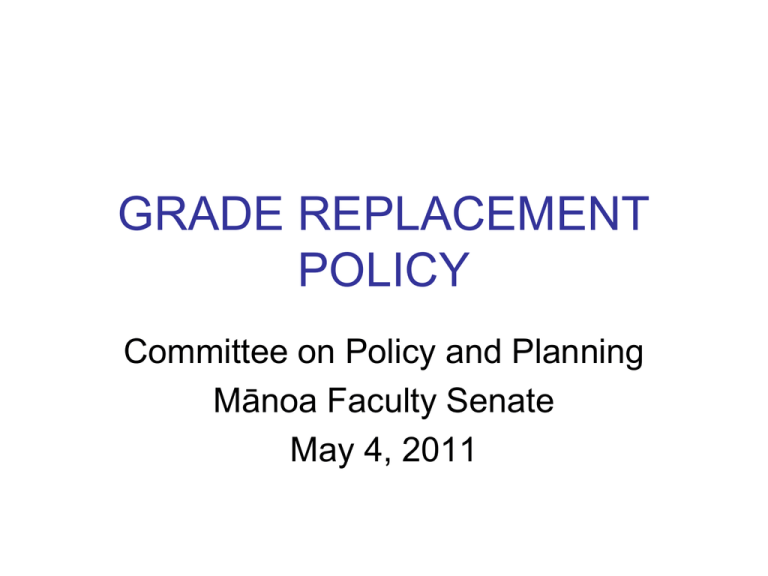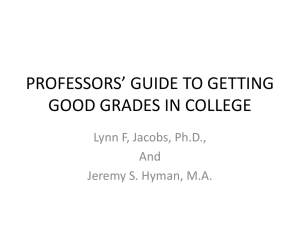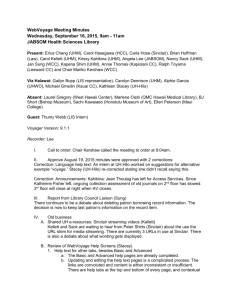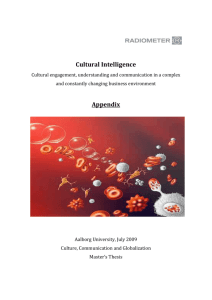CAPP Powerpoint - University of Hawaii
advertisement

GRADE REPLACEMENT POLICY Committee on Policy and Planning Mānoa Faculty Senate May 4, 2011 Background In Fall 2010, the grade replacement issue was brought to the Senate from the Administration’s Enrollment Planning Working Group on “Improving Retention and Graduation Rates at Mānoa.” CAPP was asked to consider whether Mānoa should develop a ‘replace’ grade rule for courses taken twice by students who did poorly the first time they took a course. The Problem • One of the reasons that students drop out of college is due to poor grades, usually between their second and third terms. • What is not clear is to why the remaining students were not graduating within four or six years. • Our six year graduation rate is 50.6% and our four year graduation rate is 14.5% (collegeresults.org, 2011) Graduation Rates: UHM Lags Behind in Comparison with Similar Universities Four-Six Year Graduation Rates Source: www.collegeresults.org (2011) Retention Rates: UHM Lags Behind in Comparison with Similar Universities Source: collegeresults.org (2011) Investigation of Current Academic Policies and Impact on Graduation and Retention Rates at UHM • Repeating Passed Courses (Page 16 UHM 2010/11 Catalog) Students may only repeat a course in which they received a grade of C-, D+, D, D-, F, or a NC. Degree credit for a course is given only once. The grade assigned for each repeated course is permanently recorded on the transcript. Grades for all repeated courses will be included in the GPA. • Repeating Failed Courses (Page 16 UHM 2010/11 Catalog) Students may repeat, for a letter grade only, any course in which an F was received. If this is done at UH Mānoa, credit hours and grade points for each attempt are included in the GPA. Students may repeat (but not for a letter grade) CR/NC courses in which they received a grade of NC. • Current Policy Does Not Allow Students to Repeat Courses in Which They Have Received Grades of C or Higher. In practice, however, students do repeat courses by obtaining instructor over-rides. The second grade for the same course is excluded from the calculation of the semester and the cumulative grade point average. (Students who repeat courses in which they have received grades of “C” or higher usually do so for reasons such as fulfilling pre-requisites for a competitive undergraduate or professional program and/or to improve their levels of competency in the subject matter or other reasons). • . Investigation of Current Academic Policies and Impact on Graduation and Retention Rates at UHM (continued) • Total Effect of the Existing Policies: Under “Repeating Passed Courses,” the catalog addresses repeating courses for which students received failing grades as well as low passing grades. As such, the catalog fails to clarify how the policy differs for passed courses and failed courses. • Second, the policy does not allow students to replace a lower course grade with a higher grade in calculating the GPA; the grades for all attempts are included. • Third, current policy of repeating a passed course and repeating a failed course averages both failed grades as well as low passing grades, thus it takes a student longer and costs more to attain a passing grade to enter a major and/or to graduate. In addition, data shows that students with poor/failing grades in their earlier years tend to drop out. • Fourth, students can re-take with instructor over-rides a passed course (C and higher) but the second attempt is excluded from the semester or cumulative GPa, hence the student is taking longer to graduate. • CAPP finds these policies to be unfriendly to students, to discourage students’ making further attempts to improve performance and hence gain knowledge, and to discourage some beginning students who do not perform well in their first year. Investigation of Current Academic Policies and Impact on Graduation and Retention Rates at UHM (continued) • If a student’s gpa is below 2.0 the student is placed on probation. • Data show that these students are less likely to continue on. • UHM has a 53% drop-out rate for students on probation after the completion of one year of college. Mānoa’s Data on Students Who Do Not Return After First Year Probation Same Freshman Cohort from Fall 2007 Source: Mānoa Institutional Research Office 01-11 Mānoa’s Year Over Year Student Drop-Out Rate Same Freshman Cohort from Fall 2007 Source: Mānoa Institutional Research Office 01-11 Development of the New Grade Replacement Policy to Address the Retention and Graduation rates at Mānoa • The new policy evolved from CAPP’s review of 1) repeating passed courses, and 2) repeating failed courses. • CAPP compared UHM with similar, peer, and benchmark institutions. • CAPP also compared retention and graduation rates. Proposed New Grade Replacement Policy for Mānoa • University of Hawai`i Mānoa Undergraduate students may repeat up to three (3) Mānoa courses for grade replacement. Both grades will be reflected on the transcript. However, only the higher of the two grades will be used in the calculation of the cumulative grade point average. Degree credit for any repeated course is given only once. Effect and Purpose of the Grade Replacement Policy • Encourage student success in every possible way including graduation. • Help a student to continue at Mānoa and facilitate retention. • Encourage students to gain competency in courses. • Help students shorten time to graduation & thereby spend less in tuition dollars. • Enable students to compete on the same level playing field as others who graduate from Universities that have grade replacement policies. Effect: The Current Policy on Repeating Classes Versus the New Grade Replacement Policy Current Proposed 1. 1. The Current Policy allows students to re-take classes in which they have earned below C- to F grades. 2. Averages all failed/low grades in 2. computing final GPA when a student repeats a course and passes. 3. At the end of the first year if a Freshman has 5 Cs and 3 Fs – the cumulative GPA will drop from 2.0 to 1.25 and into probation. 3. New Proposed Policy allows Three Grade Replacements in a student’s entire undergraduate years at UHM. The higher three grades will replace the poor grades. Freshman on probation. Effect: The Current Policy on Repeating Classes Versus the New Grade Replacement Policy (continued) Current Proposed 4. If the Freshman returns for a third semester, retakes the three failed courses, earns all C’s then the cumulative GPA will go up by .20 points totaling 1.45; student remains on probation. 4. If the Freshman returns for a third semester, retakes the three failed courses, earns all C’s then the cumulative GPA will go up by .75 points totaling 2.0; student is off probation. 5. A student with 111 credits of C’s and nine credits of F’s would have a GPA of 1.85 and into probation. 5. Student with 111 credits of C’s and nine credits of F’s would have a GPA of 1.85 and into probation. 6. After re-taking the 3 failed courses the student must get 3 A’s in order to bring the cumulative GPA to 2.0. If the student gets 3 C’s or 3 B’s the cumulative GPA would be 1.860 or 1.930 – still on probation and still not graduating from UHM. 6. After re-taking the 3 failed courses if the student gets 3 A’s then the cumulative GPA will go up to 2.15. If the student gets 3 C’s the cumulative gpa will still go up to 2.0. Enough to graduate from UHM within most programs and out of probation. Effect: The Current Policy on Repeating Classes Versus the New Grade Replacement Policy (Continued) Current 7. A student who has 111 credits of A’s and 9 credits of B’s and who chooses to repeat the 3 classes and earns 3 A’s the GPA remains unchanged at 3.925. A student who re-takes passed courses, the latter grades are excluded from the cumulative GPA. Proposed 7. The same student under the new policy would increase the cumulative GPA to 4.0. A mere .075 points. Will Retention and Graduation Rates for UHM Slow Down Due to the Grade Replacement Policy? • There is no evidence that indicates that a Grade Replacement Policy will increase time to graduation or reduce retention rates. • Data from other Universities that have Grade Replacement Policies suggests the opposite – UHM has one of the lowest retention and graduation rates when compared with similar institutions and we do not have a grade replacement policy. Why is CAPP Proposing Replacing Passing Grades (C to A) as Well? • UHM graduation cumulative GPA is a 2.0. • However, Mānoa has seven colleges/schools that require higher than a C average GPA for entry or exit requirements. These are: Architecture (3.0) School of Hawaiian Knowledge (3.0) College of Education (2.5) School of Nursing (2.5) School of Social Work (2.5) School of Travel Industry Management (2.5) CTAHR (2.5 to 2.8) • Hence, the policy allows students to repeat any course rather than only failing/lower grades – the policy is straight forward and is clear. Grade Replacement Policies Exists on Other UH System Campuses • UH Hilo and Kapiolani Community College both have grade replacement policies. How does this then affect our system articulation policies? • We all use the same banner and star systems for student information. CAPP’s Recommendation • Adopt the New Grade Replacement Policy and Report to encourage our students to: Succeed in every possible way including graduation; Continue on at UHM and help with retention; Gain competency in any course; Shorten time to graduation & thereby spend less in tuition dollars; Compete on the same level playing field with students who graduate from Universities that have grade replacement policies; Perceive UHM as being student friendly. CAPP Members • • • • • • • • • • • • • Chizuko Allen, SPAS Edoardo Biagioni, ICS James Cartwright, Library Tim Halliday, Economics Cynthia Hew, JABSOM Ken Kipnis, Philosophy Jon Matsuda, Outreach Katrina-Ann Oliveira, Hawaiian Knowledge Hamid Pourjalali, Accounting Sarita Rai, Study Abroad Stacey Roberts, Education Cindy Ward, English Pavel Zinin, SOEST









